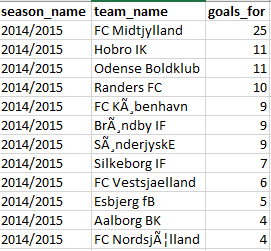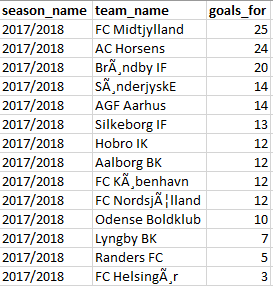I was mucking around with an analysis for a customer this week when I ran across something I hadn't looked at in a really long time - the set piece table for Danish Superliga 14-15. That was the season FC Midtjylland (FCM) won their first ever Danish title, largely on the back of scoring tons of set piece goals. Brian Priske was the set piece and defensive coach that season and he and the players probably deserve 99% of the credit for those goals, but a tiny portion of what's left should probably be apportioned to Matthew Benham for the idea that this phase of the game was exploitable, and to my own work in designing the set piece program.

Anyway, the reason why I mention it is not to break my arm patting myself on the back, but because after this nostalgic instance of stumbling across the 14-15 stats, I wondered what the 17-18 set piece table looked like.
That's when things got weird...
Background
When FCM first started having success on set pieces, we discussed how to talk about this in a few internal meetings, especially with regard to questions from the press. I distinctly remember the message we landed on being one of happily crediting player skill and a bit of luck, but under no circumstances should anyone say that we worked on these more than normal.
Set piece goals to outsiders would hopefully be written off as things that magically happened, which was just fine by me.

(This splash image is from Daniel Taylor's scathing piece on Championship owners.)
That's why I thought it was weird when pieces like Sean Ingle's one from February 2015 started appearing in the press. Why was this thing that we knew was hugely important to us and driving a lot of our success, suddenly public knowledge? I still don't actually know, to be honest. My guess was that it provided a counterpoint of positivity to the ongoing Warburton mess at Brentford, but even acknowledging the edge existed - and one that would likely be sustainable long term - seemed incredibly dumb.
One of the big rules of conducting sports analytics inside a team is that when you find an edge, you exploit the hell out of it.
And you never talk about it in public.
Why not? Because professional sport is competitive and you don't want to make your competition any smarter. Plenty of them will ignore the information or not be able figure out how to successfully exploit your edge directly, but even one team copying an edge for free is too many.
In many cases, the edge only exists because people don't know it's there to begin with. That's why many coaches and general managers/directors of football will outright lie when reporters start asking questions in these areas.
The Fallout
In a way, the public discussion created a fascinating economics question. How do actors in competitive economies adapt behaviour to new information over time? Or to put this in more obvious sports terms, what happens when a comparative league minnow wins a title on the back of scoring a lot of set piece goals, and then tells the entire world what they did?
Welcome to Denmark!

That is a lot of set piece goals. Like... a LOT. And from a whole bunch of non-Midtjylland teams. Brian Priske would later spend some time helping giants FC Kopenhagn crush the league (partly also via dominating from set pieces), and his expertise may have dispersed into greater Denmark a bit, but this whole "we too can score lots of set piece goals" idea has clearly caught on up North.
In 14-15, FCM were the only team in the league to crush this particular phase of the game, scoring 25 goals, while three other teams barely cracked 10. Three years later, eleven of fourteen teams were in double digits.
I Now Have SO MANY QUESTIONS
One of the things I used to argue about with my long-time collaborator Marek Kwiatkowski was whether working on set pieces more in training forces trade-offs in other areas. I was firmly in the "you can score more goals, period" camp (Marek is a natural uber-skeptic), but it was mostly just theory. However, now we get a chance to look at exactly that.
Are the total goal outputs largely fixed and you just shuffle between open play and set pieces, or can you just plain score more goals by adding set piece expertise? To put it another way, can you create a bigger pie or are you just carving out different sized pieces?
Set piece goals per game, 14-15: .55
Set piece goals per game, 17-18: .75
Total goals per game, 14-15: 2.41
Total goals per game, 17-18: 2.91
Set piece goals per game have gone up by .20, while overall scoring is up half a goal a game. This lends weight to the bigger pie hypothesis, and not merely different sized pieces.
Note: The Danish league changed structure between 14-15 and 17-18 by adding additional teams and the world's most complicated playoff structure, so it's not as clean as an analysis as it might otherwise be. Professional sports...
But wait, you say... some of that increase can be explained by competitive reasons, right? By increasing the league size, they probably brought in some weaker teams that were more likely to get blown out.
A fair point. Going to the first year of the 14-team league, we see... .63 goals from set pieces and 2.65 goals a game. Again, more set piece goals and more goals overall.
Shouldn't there be an equilibrium, though? Teams are scoring more set pieces, and they presumably know how to defend better against them as well, right? So why are we seeing so many more goals?
This is where we get to a bit of theory. Back when I was at FCM, someone asked our striker Duncan about defending set pieces, and his reply was that if the timing and delivery were right, the goals were basically unstoppable.
Now part of this comes back to creating complexity in your delivery and route patterns, and who you are targeting on all your different set pieces. You can't just do what England did in the World Cup and run the same play over and over again and succeed. You might be able to get away with that for a few games, but you'll struggle mightily through a league season. Defenses will adjust to that type of basic plan. However, if you are smart about your planning... well, maybe the goals actually are unstoppable.
Given the fact that the fewest set pieces goals conceded in the entire league was nine (and three seasons earlier, it was just four), either everyone in Denmark suddenly became really bad at defending set pieces or everyone became much better at executing them in ways that were difficult to stop.
I lean toward the latter.
The analysis above isn't scientific or conclusive. There are confounding factors, and football is an inherently complex game that often defies simple explanations anyway. However, I find the dramatic increase in set piece goals across the entire league here fascinating, and if we were building a case that you can increase set piece goal production at the cost of basically nothing else, we now have some evidence that perspective may be correct.
My Own Work
One of the things I am happiest about regarding set pieces is that what we built at Midtjylland was sustainable, despite the fact the coach initially responsible for the success was poached by a bigger club. Well done to Mads Buttgeireit for continuing to innovate in this area, and well done to FCM for listening when I said, "You HAVE to get Priske a fucking set piece assistant or you'll lose tens of millions of euros in value if he ever leaves."
Listening is underrated.
We also know for a fact that data analysis has dramatically changed the way that both baseball and basketball are played now. It's not just about finding better players, it's often about finding fundamentally superior styles of play before your competition and then beating them with it over and over again until they adopt your style.
In light of the above, I still find it amusing that this summer, no one on the club side came and talked to us about set pieces. The World Cup of Set Pieces was great. I broke down a lot of things, both on the site and on Twitter. Still, zero interaction.
¯\_(ツ)_/¯
In a way, this was really good, because I honestly did not have the bandwidth to spare while also launching StatsBomb Data. (I probably still don't, but football is a siren's call.) In another way, it's just continuing evidence that football is glacial when it comes to adopting new ideas from outsiders. Lest you think things are progressing behind the scenes in England, the Premier League scored 214 set piece goals in 2017-18... and 216 in 14-15. Fair dos to Bournemouth and Eddie Howe/Tom Webber for leading the league in this area last year though.
Our price for consulting on this is not cheap. We don't need to be. We still get you goals at a huge discount vs what you pay at the player or manager level without cannibalising anything else. And we teach your club personnel how to sustain this edge. The value you get at the club level is stupidly large.
And like I said above, it's not like teams were put off by the price... no one even had the conversation. *
One thing I do want to note is that if you are a national team and want help with set pieces for the Women's World Cup, definitely get in touch because like with our data, we will offer a deep discount to support the women's side of the game.
Conclusion
I will always be a nerd at heart, so finding data on how the Danish Superliga ecosystem changed after we shocked it in 2014-15 was super exciting to me and I had to write about it. While it doesn't offer conclusive proof of anything, it certainly allows you to ask interesting questions about what would happen if the rest of the football world starts to adopt advice on better ways to play the game that were reached largely via data and analytics.
Thank you for listening!
Ted Knutson
CEO, Founder StatsBomb
ted@statsbomb.com
@mixedknuts
*And I also know that plenty of you are in clubs already and listening, and you'll take what you learn from us and do it on your own and probably succeed at least somewhat, because you are smart and it's not that hard to do better than what you have now. It's probably pretty hard to score 25 every season like FCM though.
Other Writing
Changing How the World Thinks About Set Pieces Set Pieces and Market Inefficiency.
Historic data used in this piece was licensed from Opta
